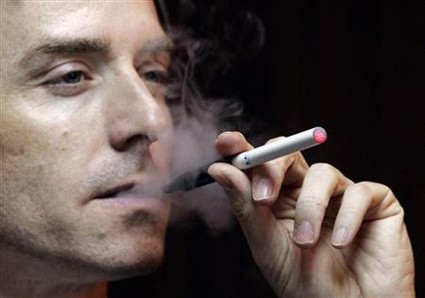Proposed ban on e-cigarettes in public places draws opposition
By Margaret Sessa-Hawkins
Maryland became the latest in a series of states struggling with how to regulate electronic cigarettes this past week when a bill aiming to ban them in public places was heard in a House committee.
Most e-cigarettes don’t contain tobacco, and don’t even emit smoke the way traditional cigarettes do. But many worry that the vapor they produce could be harmful if inhaled second hand and that, by making nicotine inhalation publicly acceptable again, e-cigarettes encourage teen addiction.
“We’ve had teachers and parents approach us about teachers in the classroom and substitute teachers vaping in front of students and we don’t believe that’s a social norm we’re trying to push forward,” Donald Shell of the Department of Health and Mental Hygiene told the House Economic Matters Committee.
Unlike traditional cigarettes, which burn tobacco, most e-cigarettes use an atomizer to vaporize a liquid solution containing nicotine, which is then inhaled by the user in a process known as ‘vaping’. Due to their relative newness, concrete data on how e-cigarettes affect health is relatively scarce.
Despite this, HB1291, sponsored by 19 delegates led by Del. Aruna Miller. D-Montgomery, aims to alter the definition of smoking in the Clean Indoor Air Act to include all forms of vaping as well, thus banning e-cigarettes in all locations where traditional cigarettes are also banned.
Ban unnecessary and counterproductive, opponents say
Opponents of the bill argue that it is unnecessary and counterproductive. They claim that far from being an equivalent to regular cigarettes, e-cigarettes are a much healthier alternative to smoking, and actually help many kick their cigarette addiction.
During the hearing scores of individuals brought personal stories before the committee of how e-cigarettes had helped them quit after decades of trying.
“Being able to use an e-cigarette in a bar or one’s office is a major draw,” said Carl Phillips, scientific director for the Consumer Advocates for Smoke-free Alternative Association. “Come for the convenience, stay for the 99% reduction in health risk.”
A counterargument, however, is that rather than reducing tobacco use, e-cigarettes actually encourage smoking by acting as a gateway device which gets users hooked on nicotine. Although manufacturers claim they market e-cigarettes primarily to those wishing to stop smoking, the number of minors using e-cigarettes more than doubled from 2011 to 2012. E-cigarettes are sold in flavors including vivid vanilla, cherry crush, and Captain Crunch.
“Lack of health warning labels and novelty flavorings have now made e-cigarettes the gateway product for many youth to a lifelong addiction to nicotine,” said Miller. “Allowing the use of these products in our schools, libraries, employment centers and public places further promotes the use of addictive products for our youth.”
Miller and other proponents of the e-cigarette ban point out that organizations have had 50 years to study the damage caused by smoking in public places and second-hand smoke. They contend that by the time adequate studies have been conducted on the effects of public and second-hand vaping, the damage may have already been done.

MarylandReporter.com is a daily news website produced by journalists committed to making state government as open, transparent, accountable and responsive as possible – in deed, not just in promise. We believe the people who pay for this government are entitled to have their money spent in an efficient and effective way, and that they are entitled to keep as much of their hard-earned dollars as they possibly can.

